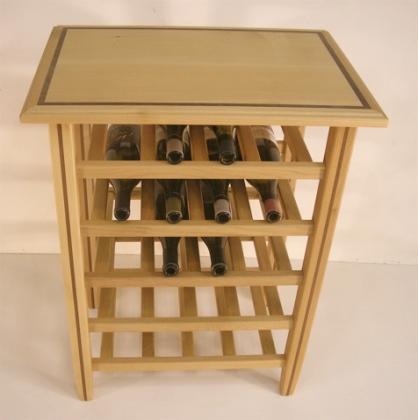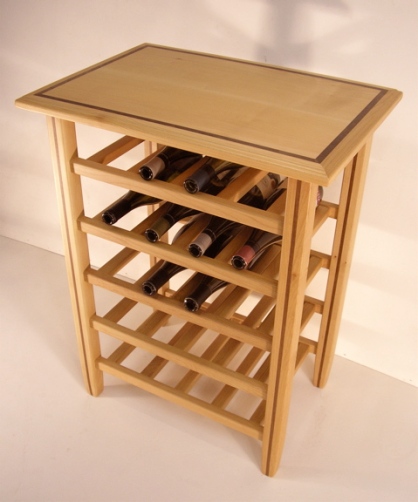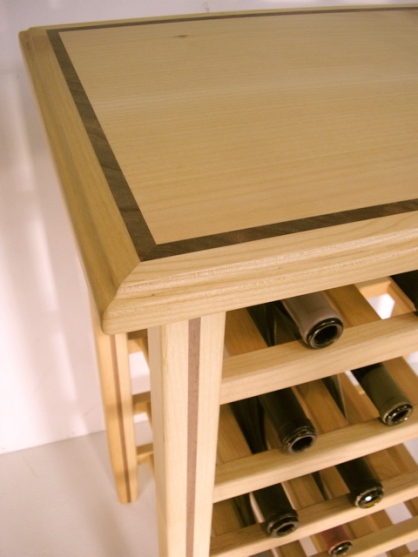Knot another wine rack!
February 16, 2011
Yeah, another one. My neighbors who make custom upholstered furniture gave me a bunch of Alder scraps a few months ago. Every month or so, they get a unit of FSC Alder lumber and proceed to make piles of narrow rips and other scraps, perfect for me to mill into rack parts.
I generally try to make parts production style so I can efficiently produce two to four or five racks at a time. This one was cut out along with the rack on my last posting. My deal is to try making all my stuff out of solid wood and not glued up… if I can. It irritates me to look at production furniture and cabinets that boast solid wood, only to see glue joints everywhere.
As I have said before, it would be easy to draw ideas up, go to the lumber yard, buy a bunch of nice material and make cool stuff. The problem is that it costs money. If I could find ways to sell these things and recover that cost, I would be cranking out wild stuff from the many pages I’ve sketched in my design note books.
Sometimes I can find big enough pieces to make solid legs, but in this case, the scraps were wide and long enough, but not thick enough. To solve that, I laminate a different kind of wood so it becomes a part of the design, not just a way to use thinner (cheaper) material, like the typical manufacturing process. In the end, it’s no doubt cheaper, easier, to buy thicker 8/4 material for the legs, but like I said, it cost money. I have way more time than money. I began laminating parts so that they becomes part of the design and look on purpose. In this case, Oregon Black Walnut milled from some logs I dried.
The field for the tops are usually two pieces glued up, either book matched or a single board folded back on itself at the cut, so that the grain matches and many times make the joint invisible. I started using a contrasting feature strip when I laminate the tops for the same reason… make big parts out of small pieces and have the laminations be part of the design.
Knot normally the way I do it…
February 10, 2011
A lady saw photos of a wine rack I posted for sale on craigslist and contacted me. I invited her to the shop to see what different pieces I have in my inventory. She had a corner in her dining room where she wanted to place it and we discussed dimensions.
She looked at completed racks and I explained how the modular nature effected the over all dimensions. She gravitated to a piece that was constructed from Black Walnut and Sapele, and said she really liked the redish color of the Sapele… also know as African Mahogany. She ask what color of stain I used.
I had to laugh and said that there was no stain, I use different hardwoods to show off their natural color. There is no reason to use a stain. I do however use stains on the pieces I make out of soft wood like Pine, Fir or Cedar. I showed her a couple of those different pieces and some raw wood to illustrate how washed out the natural wood looks generally. She wanted, if not to match, at least compliment her dining room table.
She ask how much the Walnut/Sapele piece was and I said it was three times as expensive as the Fir/Pine ones. It was too small for her but she really liked it. I had to laugh again. I said, you have good taste, your like my wife. She sees a red car and says, wow that is a beautiful car, I want one of those. I say, baby you have good taste… that is a Ferarri. How about that red car over there? No, I don’t like that so much. Well Babe, that’s a Toyota.
I had three racks made from Alder that were recently glued up but I had not made tops for yet. They were the right dimension and bottle capacity for her. I showed her the two most common tops I make… Mitered edge band, with or without a contrasting feature strip, and the Breadboard style with through tenon joint.
She liked the Breadboard style, saying that the way I leave the tenon protruding matched her table’s styling. I told her that I never stain hardwoods, but that furniture manufacturers routinely apply stains to Alder. I pulled out my drawer full of sample stain cans and proceeded to wipe stain on some Alder scraps. The first one or two colors were spot on for her. So I made a Breadboard top, stained the piece and applied three coats of polyurethane.
She picked it up yesterday and said it looked great. As much as I would love to be purist, use highly figured exotic woods and tradition oil and wax finishes… I’m not a snob. In the real world, it’s only other woodworkers that really know the difference between a Ferrari and a Toyota… or care. While it’s Knot normally how I do things, it pays the bills. I did like the way it turned out and more importantly so did she. Thanks for the support… another one goes to a good home.







